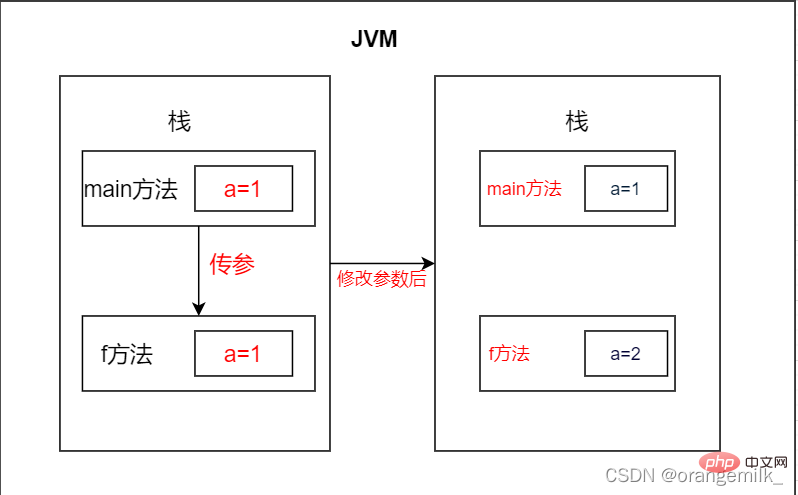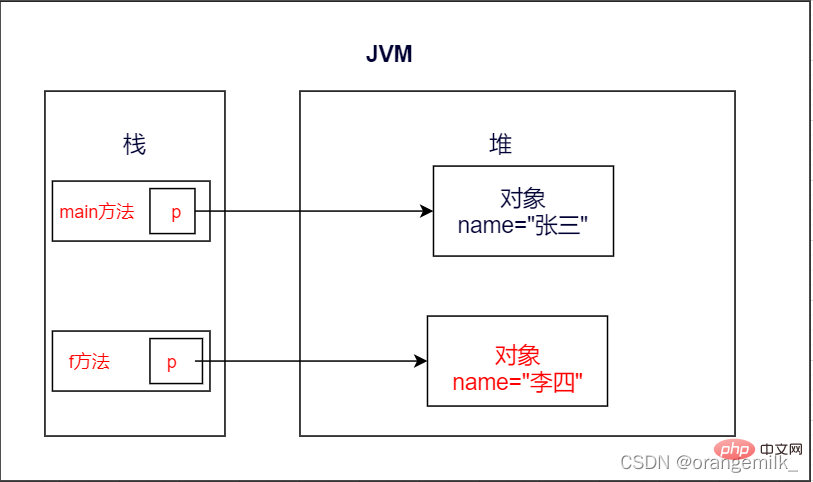Let's analyze whether Java is passed by value or by reference.
This article brings you relevant knowledge about java, which mainly introduces the relevant issues about whether Java is passed by value or passed by reference. Let's take a look at it together. I hope it will be helpful to everyone. helpful.

Recommended study: "java Video Tutorial"
Purpose of the article: Verify whether the Java language is pass by value or pass by reference and Java Implementation principle of parameter passing.
Problem introduction:
Read the code segment first:
public static void main(String[] args){
Person p=new Person("张三");
f(p);
System.out.println("实参:"+p);}public static void f(Person p){
p.name="李四";
System.out.println("形参:"+p);}Running result:
Formal parameters :Person{name="李思"}
Actual parameters:Person{name="李思"}
We pass an object variable to the method, and then modify the object within the method Attributes, print actual parameters and formal parameters, on the surface, the values of the actual parameters and formal parameters have been modified.Does Java also support reference transfer?
| The answer is: Java language only supports value transfer and does not support reference transfer. |
Before verifying the Java parameter transfer method, we First, you must understand the difference between function value passing and reference passing.
- Pass by value means copying a copy of the actual parameters and passing them to the function when calling the function, so that if Modifying parameters will not affect the actual parameters.
- Pass by reference refers to passing the address of the actual parameters directly to the function when calling the function. Then the modification of the parameters in the function will affect the actual parameters.
It can be seen that the difference between value passing and reference passing is whether the modification of the formal parameters will affect the actual parameters
1. Basic Parameter passing of data type
We pass a basic data type to the method, and then modify the value of the formal parameter in the method, and find that the modification of the formal parameter does not affect the actual parameter.
public static void main(String[] args){
int a=1;
f(p);
System.out.println("实参:"+a);}public static void f(int a){
a=2;
System.out.println("形参:"+a);}2. Parameter passing of reference data types
In the example introduced by the question, it seems that the modification of the formal parameters affects the actual parameters, but as long as we create a new object and assign it to the formal parameters, then Print actual parameters and formal parameters, the two do not affect each other. It means that Java does not conform to reference transfer.
public static void main(String[] args){
Person p=new Person("张三");
f(p);
System.out.println("实参:"+p);}public static void f(Person p){
p=new Person("李四");
System.out.println("形参:"+p);}3. Principle
We need to understand why this happens Phenomenon, you need to understand the basic principles behind Java:
The JVM is divided into many areas, the objects we create are placed on the heap, and basic data types and local variables are placed on the stack. When passing the basic data type, a copy of the data is created and passed to the method, so the actual parameters will not be affected by the modification of the formal parameters, as shown in the figure:

Since the object is placed In the heap area, so we can only use the reference of the object to operate this object.
When the object reference is passed to the method, a copy of the reference is actually created and points to the same object at the same time. When the object is manipulated through the formal parameter reference , it’s like the actual parameters have changed. In fact, the object content has changed, but the object variables have not changed, and the actual parameters themselves have not changed. Therefore, the example introduced in the question is not difficult to understand.

When we reassign the formal parameters, the actual parameters will not be affected in any way. At this time, the actual parameters and the formal parameters already point to two different objects.
Therefore, Java only supports value transfer.
Recommended learning: "java video tutorial"
The above is the detailed content of Let's analyze whether Java is passed by value or by reference.. For more information, please follow other related articles on the PHP Chinese website!

Hot AI Tools

Undresser.AI Undress
AI-powered app for creating realistic nude photos

AI Clothes Remover
Online AI tool for removing clothes from photos.

Undress AI Tool
Undress images for free

Clothoff.io
AI clothes remover

Video Face Swap
Swap faces in any video effortlessly with our completely free AI face swap tool!

Hot Article

Hot Tools

Notepad++7.3.1
Easy-to-use and free code editor

SublimeText3 Chinese version
Chinese version, very easy to use

Zend Studio 13.0.1
Powerful PHP integrated development environment

Dreamweaver CS6
Visual web development tools

SublimeText3 Mac version
God-level code editing software (SublimeText3)

Hot Topics
 1664
1664
 14
14
 1422
1422
 52
52
 1316
1316
 25
25
 1266
1266
 29
29
 1239
1239
 24
24
 Break or return from Java 8 stream forEach?
Feb 07, 2025 pm 12:09 PM
Break or return from Java 8 stream forEach?
Feb 07, 2025 pm 12:09 PM
Java 8 introduces the Stream API, providing a powerful and expressive way to process data collections. However, a common question when using Stream is: How to break or return from a forEach operation? Traditional loops allow for early interruption or return, but Stream's forEach method does not directly support this method. This article will explain the reasons and explore alternative methods for implementing premature termination in Stream processing systems. Further reading: Java Stream API improvements Understand Stream forEach The forEach method is a terminal operation that performs one operation on each element in the Stream. Its design intention is
 PHP: A Key Language for Web Development
Apr 13, 2025 am 12:08 AM
PHP: A Key Language for Web Development
Apr 13, 2025 am 12:08 AM
PHP is a scripting language widely used on the server side, especially suitable for web development. 1.PHP can embed HTML, process HTTP requests and responses, and supports a variety of databases. 2.PHP is used to generate dynamic web content, process form data, access databases, etc., with strong community support and open source resources. 3. PHP is an interpreted language, and the execution process includes lexical analysis, grammatical analysis, compilation and execution. 4.PHP can be combined with MySQL for advanced applications such as user registration systems. 5. When debugging PHP, you can use functions such as error_reporting() and var_dump(). 6. Optimize PHP code to use caching mechanisms, optimize database queries and use built-in functions. 7
 PHP vs. Python: Understanding the Differences
Apr 11, 2025 am 12:15 AM
PHP vs. Python: Understanding the Differences
Apr 11, 2025 am 12:15 AM
PHP and Python each have their own advantages, and the choice should be based on project requirements. 1.PHP is suitable for web development, with simple syntax and high execution efficiency. 2. Python is suitable for data science and machine learning, with concise syntax and rich libraries.
 PHP vs. Other Languages: A Comparison
Apr 13, 2025 am 12:19 AM
PHP vs. Other Languages: A Comparison
Apr 13, 2025 am 12:19 AM
PHP is suitable for web development, especially in rapid development and processing dynamic content, but is not good at data science and enterprise-level applications. Compared with Python, PHP has more advantages in web development, but is not as good as Python in the field of data science; compared with Java, PHP performs worse in enterprise-level applications, but is more flexible in web development; compared with JavaScript, PHP is more concise in back-end development, but is not as good as JavaScript in front-end development.
 PHP vs. Python: Core Features and Functionality
Apr 13, 2025 am 12:16 AM
PHP vs. Python: Core Features and Functionality
Apr 13, 2025 am 12:16 AM
PHP and Python each have their own advantages and are suitable for different scenarios. 1.PHP is suitable for web development and provides built-in web servers and rich function libraries. 2. Python is suitable for data science and machine learning, with concise syntax and a powerful standard library. When choosing, it should be decided based on project requirements.
 PHP's Impact: Web Development and Beyond
Apr 18, 2025 am 12:10 AM
PHP's Impact: Web Development and Beyond
Apr 18, 2025 am 12:10 AM
PHPhassignificantlyimpactedwebdevelopmentandextendsbeyondit.1)ItpowersmajorplatformslikeWordPressandexcelsindatabaseinteractions.2)PHP'sadaptabilityallowsittoscaleforlargeapplicationsusingframeworkslikeLaravel.3)Beyondweb,PHPisusedincommand-linescrip
 Java Program to Find the Volume of Capsule
Feb 07, 2025 am 11:37 AM
Java Program to Find the Volume of Capsule
Feb 07, 2025 am 11:37 AM
Capsules are three-dimensional geometric figures, composed of a cylinder and a hemisphere at both ends. The volume of the capsule can be calculated by adding the volume of the cylinder and the volume of the hemisphere at both ends. This tutorial will discuss how to calculate the volume of a given capsule in Java using different methods. Capsule volume formula The formula for capsule volume is as follows: Capsule volume = Cylindrical volume Volume Two hemisphere volume in, r: The radius of the hemisphere. h: The height of the cylinder (excluding the hemisphere). Example 1 enter Radius = 5 units Height = 10 units Output Volume = 1570.8 cubic units explain Calculate volume using formula: Volume = π × r2 × h (4
 PHP: The Foundation of Many Websites
Apr 13, 2025 am 12:07 AM
PHP: The Foundation of Many Websites
Apr 13, 2025 am 12:07 AM
The reasons why PHP is the preferred technology stack for many websites include its ease of use, strong community support, and widespread use. 1) Easy to learn and use, suitable for beginners. 2) Have a huge developer community and rich resources. 3) Widely used in WordPress, Drupal and other platforms. 4) Integrate tightly with web servers to simplify development deployment.




